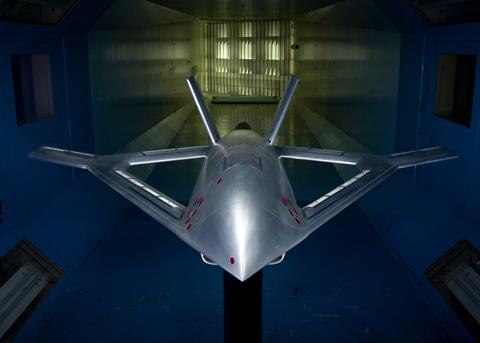Boeing subsidiary Aurora Flight Sciences has begun manufacturing a secretive new X-plane for the US military, designated the X-65.
Aurora is under contract to develop the experimental jet aircraft for the Defense Advanced Research Projects Agency (DARPA) – the Pentagon’s internal technology development wing.
The X-65 is being designed around a concept called “active flow control” (AFC), which eliminates use of traditional moving control surfaces to manoeuvre an aircraft. Instead, AFC uses actuators and effectors to modify surface airflow by directly adding energy or momentum.
“AFC may deliver benefits in areas such as aerodynamics, weight, and mechanical complexity,” Aurora says. The company notes its X-65 design is meant to demonstrate the benefits of AFC technology for both commercial and military applications.

The company on 3 January said it has begun fabricating its X-65 prototype after three years of preliminary design work and windtunnel testing under DARPA’s Control of Revolutionary Aircraft with Novel Effectors (CRANE) programme.
“As we move into the manufacturing phase, we are getting ever closer to fulfilling the goal of validating AFC technology and helping to open the design trade space for future applications,” says Kevin Uleck, CRANE programme director at Aurora. “X-65 has the potential to change the future of aircraft design.”
The milestone follows Aurora’s successful completion of a critical design review by DARPA, which concluded the current X-65 design progress demonstrates technical and manufacturing viability to continue funding.
Aurora was awarded an initial $42 million CRANE contract from DARPA in December 2022 to fund development of what has become the X-65. The company advanced to the second phase shortly after in January 2023.
“CRANE seeks to optimise the benefits of active flow control by maturing technologies and design tools, and incorporating them early in the design process,” DARPA says. “Active flow control could improve aircraft performance by removing jointed surfaces, which currently drive design configurations that increase weight and mechanical complexity.”
Aurora says the X-65 is purpose-designed around the use of AFC for multiple effects, including flight control at tactical speeds and “performance enhancement across the flight envelope”.
The X-65’s AFC system supplies pressurised air to 14 effectors embedded across all flying surfaces, including multiple wing sweeps, which are used to provide aerodynamic control.
Aurora says the experimental aircraft is configured to be modular, featuring replaceable outboard wings and swappable AFC effectors, which will allow for the future testing of additional AFC designs.
While the company has not released any details about the X-65’s propulsion system, the X-plane appears to be jet-powered. Aurora says the CRANE programme will culminate in the production of a full-scale, flight-capable aircraft weighing 3,175kg (7,000lb) and able to reach speeds up to 463kt (857 km/h).
That airspeed is equivalent to Mach 0.7.
Flight testing for the X-65 is currently targeted for summer 2025, according to Aurora.
Component tooling and part fabrication for the 9.14m (30ft) wingspan, uncrewed aircraft are now underway at Aurora facilities in West Virginia and Mississippi, the company says.
The airframe will be assembled at Aurora West Virginia, followed by system integration and ground testing at Aurora’s headquarters in Manassas, Virginia.


























